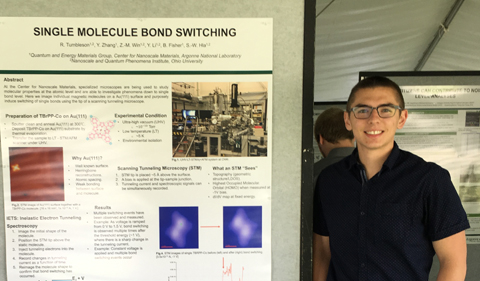By Ryan Tumbleson ’20
B.S. Engineering Physics and B.S. Electrical Engineering, Honors Tutorial College
I had the opportunity to receive a second consecutive summer internship at Argonne National Laboratory near Chicago. For 10 weeks I worked under the direction of Ohio University physics professor Dr. Saw Wai-Hla. Dr. Hla has a unique joint appointment at Argonne National Lab and Ohio University’s Physics & Astronomy Department and Nanoscale & Quantum Phenomena Institute.
My research focus at Argonne included advanced scanning probe studies of single molecules and nanostructures.
Our research group included Dr. Hla, Dr. Yuan Zhang (Ph.D. graduate from Ohio University), Hao Chang (Ph.D. student at Ohio University), Yang Li (Ph.D. student at Ohio University), Zaw-Myo Win (Ph.D. student at City University of Hong Kong), and Dr. Nozomi Shirato and Dr. Volker Rose (physicists at Argonne).
The internship locations at the lab were familiar to me from my previous summer internship. During the first few weeks I worked in the Advanced Photon Source beamline researching mono-layer structures with the Synchrotron X-Ray Scanning Tunneling Microscope (SX-STM). During the second half of the summer, I worked on the ultrahigh vacuum low temperature scanning tunneling microscopy/q+ atomic force microscopy (UHV-LT-STM/q+ AFM) materials characterization instrument analyzing properties of a single molecule switch. While performing these experiments, I learned how to use a qPlus atomic force microscope (q+AFM) and the basic physical principles behind the measurements.
This research provides information to what is unknown. Whether it is developing equipment (SX-STM) to be able to study nanoscopic phenomena in a new way or analyzing the properties of a single molecule switch, these are the stepping stones to even broader research in the future.
Doing research has taught me the value of asking questions. Even the best scientists at Argonne are constantly asking questions and reading papers to understand things that they do not currently know. There are several aspects to everything that is being researched, and no one person has full information of the experiment or the situation. I have witnessed firsthand how collaboration is essential to fill in those gaps.
One challenge for me during the summer was time management. Along with my lab duties, I took an online summer course from Ohio University, participated in a local community jazz band, and wanted to spend time with the other student interns at Argonne. The hours that I worked at Argonne were not always regular and depended on what time of day or night an experiment was taking place.
I found it beneficial to go through each week and prioritize what is important and tackle responsibilities systematically. It is good to have a rough idea of when something is going to be done and try to stick to that schedule as much as possible. It is also important to still be flexible enough to adapt when something happens differently than expected.
I would definitely recommend the internship experience to other physics students. It is a wonderful experience to be able to participate in high-level research. The scientists I encountered had a broad range of expertise and a genuine openness to share their knowledge with the interns.
One highlight for me was presenting some of my research at a conference sponsored by Argonne at the end of the summer. I presented a poster at the Student Poster Symposium titled “Single-Molecule Bond Switching.” This poster presentation was to Argonne employees and other summer interns from all different areas of the lab—not just the Center for Nanoscale Materials. The overall feedback I received was positive, and the experience helped me to see areas of strength and weakness in my presentation abilities.




















Comments